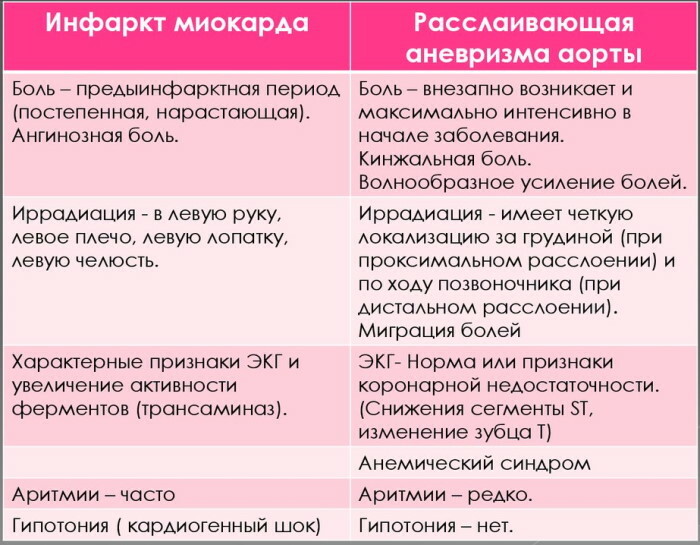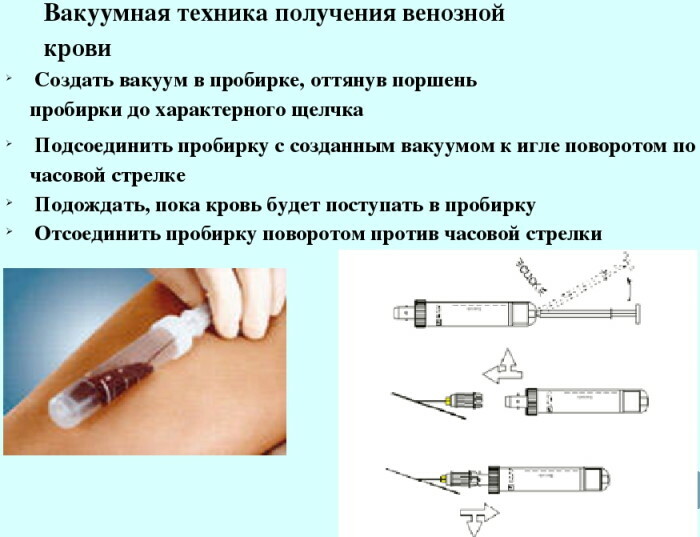Content
- Features of the anatomy of the head and neck
- Functions and properties
- Anatomy and schematic
- Possible diseases and pathologies
- Atherosclerosis of the vessels of the head and neck
- Symptoms and Signs
- Causes
- Treatment methods
- Stroke
- Symptoms and Signs
- Causes
- Treatment methods
- Hypertension
- Symptoms and Signs
- Causes
- Treatment methods
- Vegetovascular dystonia
- Symptoms and Signs
- Causes
- Treatment methods
- Vascular dilatation
- Causes
- Symptoms and Signs
- Treatment methods
- Video about the arteries of the head and neck
Head and neck arteries originate in the carotid artery and have many branches. The anatomy of the blood vessels of the head and neck is a complex plexus of different parts of the blood vessels, each of which has its own purpose, location and name. All of them perform a single function of ensuring the supply of blood to the head and neck, along with nutrients and oxygen, so they penetrate even the most inaccessible tissues. All the arteries of the head and neck are interconnected and any disruption in their work leads to serious consequences.
Features of the anatomy of the head and neck
The arteries of the head and neck, the anatomy of which has been sufficiently studied, have a complex structure. All arteries in the neck and head branch off from the aortic arch. The largest and most important vessels in this area are the left carotid artery and the brachiocephalic trunk, the subclavian left artery. They are the largest and strongest, so they never suffer from blockages or loss of functionality.
The left carotid artery at the level of the thyroid gland bifurcates into internal and external, each of which is divided into several smaller arteries. Those, in turn, are subdivided into even narrower arteries and capillaries, which cover with their frequent weaving all the tissues of the neck and head.
Small vessels permeate the entire brain, providing it with uninterrupted power in the first place. The vessels of the neck and head are of great importance, since they supply nutrients and oxygen not only to the brain, but also to the face, organs of the larynx, eyes and nose. Any disturbance in the work of the arteries of this department provokes a violation of speech, vision, loss orientation or hearing, as well as cerebral hypoxia of varying degrees, which disrupts the work of everything organism.
The arteries of the neck have wide gaps, so it is in these places that the pulse of a person can be easily heard in any condition. Due to the high pressure in the arteries of the neck, with minor damage, a person can lose a lot of blood, and extensive trauma to these vessels can be fatal in a matter of minutes.
All arteries of the head and neck penetrate the soft tissues, skin and muscle tissues of the neck and head to the same extent. Due to the peculiarities of the location, blood after the heart enters the brain first of all and saturates it with oxygen and nutrients.
The complex structure of the circulatory system in the head and neck shows that large arteries approach the main important points. heads, where the arteries gradually divide into many small arteries and capillaries for pinpoint delivery of blood to the site destination. In this case, blockage or narrowing of even 1 capillary can affect the occurrence of hypoxia in the brain.
Functions and properties
The arteries of the head and neck, the anatomy of which is easily accessible in the form of diagrams and maps, have a complex structure and originate in the left carotid artery. Arteries in the head and neck provide blood circulation to all tissues of the human head.
The main functions of arteries include:
- transfer of blood from the heart to the capillaries;
- presence as a reservoir to create the desired pressure when pushing blood into the arterioles;
- smoothing pressure and multi-volume blood flow for uninterrupted blood delivery to capillaries;
- redistribution of blood between capillaries due to the presence of resistive vessels;
- the supply of oxygen and nutrients to the tissues of the body is constant;
Arteries are of different types and have different structures depending on their location and function.
But all of them are characterized by the presence of:
- thick walls that are much wider than veins of the same diameter;
- increased elasticity (the ability to expand and contract, withstand different levels of blood flow and smooth it);
- strong walls (thick or multi-layered walls can withstand increased blood pressure);
- slight inclusion of smooth muscle fibers, which further strengthens the arteries and allows them to expand and contract.
Due to the increased elasticity, the vessels are able to take any shape and quickly recover from ruptures with minor damage. Even in the event of a complete rupture of the vessel, including after trauma, it can be restored by surgical intervention and restorative therapy.
Anatomy and schematic
The arteries of the head and neck, whose anatomy is quite complex, like any arteries, are blood vessels that carry blood from the heart to the legs. Arterial blood is always saturated with nutrients, oxygen and has a bright red hue, so the arteries merge with the tissues in color. The pressure in the arteries is always higher than in the veins, so they have strong walls. The temperature in the arteries is also higher than in the veins due to the higher pressure.
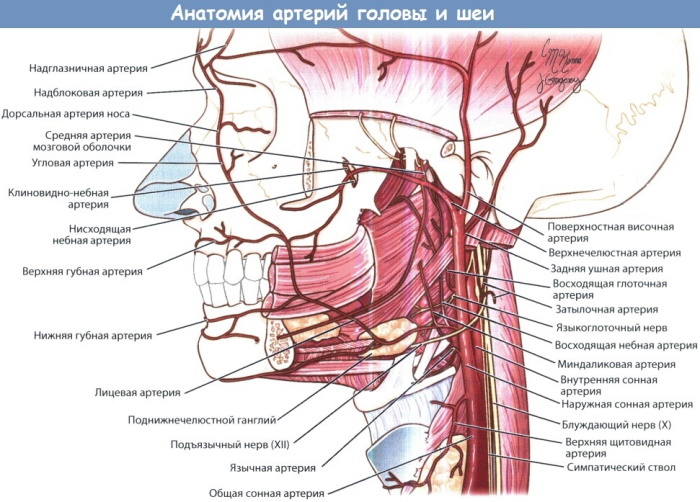
The arteries of the head and neck are found mainly on the left side of the neck and evenly throughout the head. The arteries of the neck are mirrored on the right by the veins. On the right side, the common carotid and subclavian veins start from the brachiocephalic trunk, and on the left side, the carotid and subclavian arteries originate from the convex part of the aortic arch.
The carotid left artery is located on the neck beyond the collarbones. In the upper part, the carotid artery is divided into external and internal.
The external carotid artery is directed upward and passes through the areas of the face and head.
This artery is subdivided into:
- the lingual artery and its branches, which run throughout the tongue, cavity and muscles of the mouth, as well as the salivary glands;
- the posterior auricular artery, which supplies blood to the auricle, middle ear, and adjacent tissue;
- the upper thyroid artery, which is responsible for supplying blood to the tissues of the larynx, thyroid gland, partly the muscles of the clavicle and tissue of the hyoid bone;
- the ascending pharyngeal artery, which covers the walls of the pharynx, ear, palate, and the dura mater;
- the facial artery, the branches of which supply nutrients to the pharynx, tonsils, muscles around the nose, mouth, mouth and palate;
- the occipital artery, which brings blood to the skin and muscles of the occipital region, the inside of the ear, and partly to the meninges.
At the beginning of the jaw, the external carotid artery divides into the temporal artery and the maxillary artery. The first covers the temporal regions of the head, cheeks, and the second is located in the infratemporal region and nourishes the muscles and tissues of the upper part of the face, teeth, the inside of the nose and middle ear.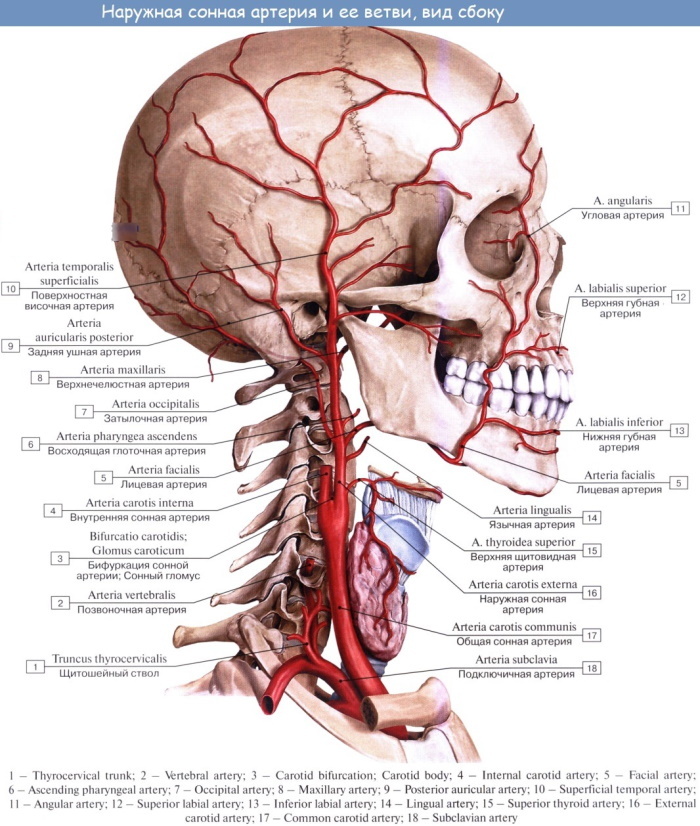
The maxillary artery is large enough and is subdivided into:
- the middle meningeal artery and the inferior alveolar arteries, which supply blood to the teeth and oral cavity;
- the infraorbital artery, which brings nutrients to the area around the eye;
- the descending palatine artery, which additionally supplies blood to the surface of the palate and partially to the nasal cavity;
- the wedge-palatine artery that runs along the mucous membrane and walls of the nose and throat.
The internal carotid artery is located behind the outer part of the same artery. It consists of a cervical and intracranial branch. Inside the neck, the branches do not leave the artery.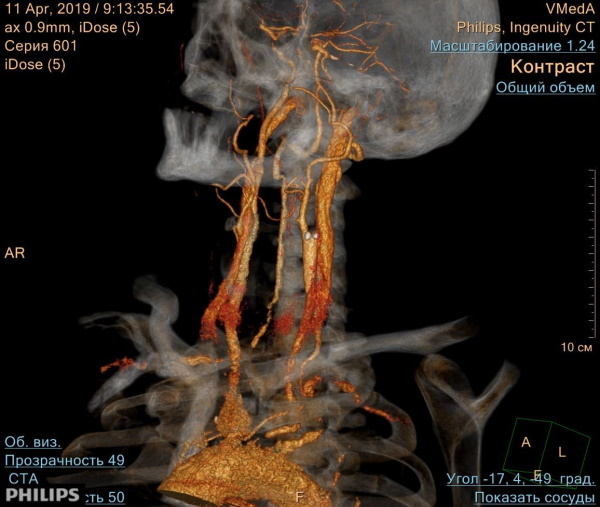
And in the cranial cavity, the artery is subdivided into:
- ophthalmic, which penetrates the eye completely, lacrimal glands and eyelids.
- the anterior cerebral artery, which saturates the frontal and parietal part of the brain with blood.
- the middle cerebral artery, which affects the frontal and temporal parts of the brain, as well as the parietal region.
- the posterior connecting artery, which supplies blood to the back of the brain and connects to the vertebral artery.
Possible diseases and pathologies
Each major artery of the head and neck has many additional branches to the vessels and capillaries, which often penetrate the tissue with a fine mesh. This structure allows you to deliver nutrients to all parts of the body quickly and in the right amount.
Atherosclerosis of the vessels of the head and neck
The arteries of the head and neck, whose anatomy indicates the presence of many small vessels, are often prone to atherosclerosis. Normally, the vessel has an even wide lumen for the delivery of blood to the tissues. However, due to the presence of concomitant diseases, improper lifestyle and nutrition, vessels can gradually become clogged with fatty plaques or pieces of tissue.
Pieces of fat, emboli (blood clots, foreign particles or tiny tissue elements) settle on the walls of blood vessels, reducing the lumen. As a result, the pressure in the area of the artery with the plaque rises sharply and the vessel cannot expand and narrow in the usual way. All this can lead to rupture or damage to the artery, impaired circulation. If left untreated, the artery can become completely blocked by fatty deposits or emboli. The most common cause of vascular stenosis is atherosclerosis.
Symptoms and Signs
With the development of atherosclerosis, the patient manifests itself:
- headache and heaviness in the head;
- noise in ears;

- reduced performance;
- sleep disturbance;
- increased cranial pressure;
- speech disorder;
- memory problems;
- fainting.
Causes
The reasons for the onset and development of atherosclerosis in the body can be:
- infections;
- trauma;
- hormonal disruptions;
- autoimmune diseases;
- metabolic disorders, diabetes mellitus;
- high cholesterol levels.
Treatment methods
In the presence of atherosclerosis, blockage of the vessels of the head and neck, the patient is recommended to have a dietary diet, systematic exercise and restoration of the daily routine.
Additionally, drug treatment is prescribed with drugs for:
| strengthening blood vessels | cennarizine, troxerutin |
| reduce cholesterol levels | atorvastin, resuvastatin |
| restoring blood microcirculation and relieving spasms | no-shpa, chime |
If the classical treatment is insufficient, the patient can undergo an operation to transplant the vessel or expand it by bypassing.
Stroke
A spasm in a small or large area of the brain changes the properties of an artery. The arteries of the head lose their elasticity and cannot fully perform their functions. As a result, hemorrhage or rupture of cerebral vessels can occur in the head, which ultimately leads to hypoxia. If a small area of the head is damaged, the blood supply can recover on its own, an extensive lesion causes impaired speech, mobility and can be fatal.
Symptoms and Signs
After the onset of hypoxia, a person develops:
- shortness of breath and impaired attention appear;
- asymmetry of the face;
- sudden weakness and dizziness;
- the inability to raise your hands up;
- headache and partial loss of vision.
Causes
A stroke appears when:
- alcohol abuse;

- increased physical and mental stress;
- high blood pressure;
- atherosclerosis.
Treatment methods
For the treatment of a stroke, the patient is prescribed:
| drugs to reduce blood clotting | fibrinolysin, streptokinase, tenecteplase |
| spasmolytics | no-shpa, drotaverin |
| drugs to reduce blood pressure | verapamil, norvasc |
| supportive and restorative drugs for the acute stage of stroke development | chime, dopegit, cinnarizine |
Hypertension
The arteries of the head and neck often suffer from hypertension, since the anatomy of the structure of small arteries is not strong enough with increased pressure. Hypertension is the constant presence of high blood pressure in a person. With a normal blood pressure in an adult at 120/80, a hypertensive person may have a normal blood pressure of 135/80. Often in such people, the pressure rises daily to 150/90 and above.

In this case, the entire load is reflected in the work of the heart, the condition of the arteries of the neck and head.
Symptoms and Signs
With hypertension, a person has:
- severe weakness;
- frequent dizziness, decreased concentration;
- nausea and vomiting;
- slight increase in temperature (up to 37.1 ° C);
- tinnitus, darkening in the eyes;
- dyspnea;
- blanching of the skin and a rush of blood to the face area.
In such cases, the arteries of the head and neck experience overstrain, often spasm, especially small vessels. As a result of the development of hypertension, individual arteries of the head wear out quickly, they can not withstand and rupture. Extensive bleeding in the brain causes hypoxia and death.
Causes
The main causes of hypertension are:
- diabetes;
- improper nutrition;
- high cholesterol levels;
- sedentary lifestyle and hereditary predisposition;
- cardiovascular diseases;
- alcohol abuse;
- increased physical activity.
Treatment methods
Treatment of hypertension consists in the systematic administration of drugs that lower blood pressure (bisoprolol, nebivolol, metaprolol). 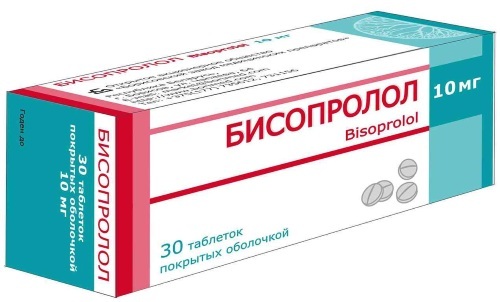 The patient is recommended dietary nutrition, sports and giving up bad habits.
The patient is recommended dietary nutrition, sports and giving up bad habits.
Vegetovascular dystonia
Vegetovascular dystonia or disruption of the nervous autonomic system leads to a change in the functioning of the cardiovascular system, thyroid gland, and the digestive system.
Symptoms and Signs
With the development of VSD, the patient constantly has high or low blood pressure, a slight increase in temperature and insomnia. Headache, tinnitus may be present.
Causes
This disease most often appears due to:
- hereditary predisposition;
- stress;
- physical or mental fatigue;
- hormonal changes;
- infectious diseases of the respiratory tract, genitourinary system.
Treatment methods
In the absence of proper treatment, the disease can lead to the development of hypertension and stroke, heart attack. Cause chronic disturbances in the work of the heart and arteries of the brain, affect the increase in intracranial pressure. In case of detection of VSD, preparations of complex action (eltacin, glycine), as well as symptomatic action (andipal, dopegit, no-shpa) are prescribed.
Vascular dilatation
Vascular dilatation of the arteries of the head and neck appears when, due to a decrease in the stabilization of the vessel wall, it sharply changes from the diameter of the arteries to the direction of increase. The vessel ceases to narrow to the desired volume and to regulate blood flow.
Causes
The increase is a consequence of the stratification of the vessel walls, which appear as a result of atherosclerosis, hypertension, increased physical exertion or disturbances in the work of the cardiovascular system.

Symptoms and Signs
With this disease, the patient develops headaches, tinnitus, fatigue and weakness. Increased irritability and nosebleeds are constantly present. In rare cases, patients have high blood pressure and poor vision.
Treatment methods
This change requires complex treatment.
The patient is recommended:
- drugs to lower blood pressure (captopril, bisoprolol);
- drugs to restore the lumen of blood vessels (troxerutin, piricarbate, tribenoside);
- as well as multivitamin complexes (alphabet, complevit).
During treatment, it is important to exclude increased physical activity and eat dietary food according to the regimen.
The arteries of the head and neck are complex and vary in size from the large to the smallest arteries that penetrate the tissues. For effective blood supply to all tissues of the head and neck, according to the anatomical structure, individual arteries are located in hard-to-reach places, therefore it is possible to treat them by surgical intervention impossible.
Prevention is an important factor in maintaining the health of the arteries in the head and neck. If there are changes in the general state of health, the patient should immediately contact a specialist and undergo a course of drug treatment to restore health in order to avoid possible complications.
Video about the arteries of the head and neck
Blood supply to the brain:

